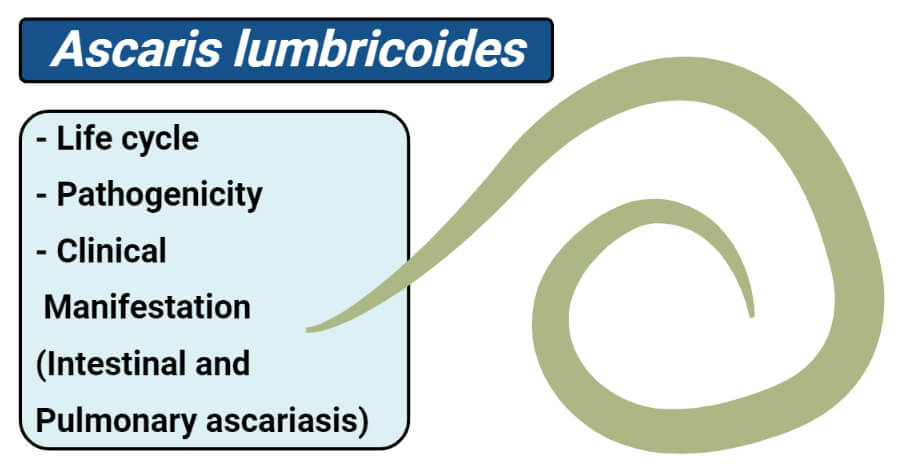Interesting Science Videos
Life cycle of Ascaris lumbricoides
- In the life cycle of Ascaris, there is no secondary host.
- The life cycle of Ascaris is monogenetic as it involves only one host i.e. Man.

Figure: Life cycle of Ascaris lumbricoides. Image Source: CDC.
1. Egg in feces
- The sexually mature female produces as many as 200,000 eggs per day, which are shed along with feces in unembryonated form. They are non-infective.
2. Development in soil
- Embryonation occurs in the soil at an optimum temperature of 20-25ºC with sufficient moisture and O2.
- The infective larva develops within the egg in about 3-6 weeks.
3. Infection to host
- Man acquires infection directly by swallowing the infected egg of Ascaris containing the infective second stage rhabditoid larva with contaminated food and water.
- When the infected egg reaches the small intestine of the host, by the action of digestive juice, the eggshell dissolved and the juveniles (second stage larva) are set free.
- The juveniles are about 0.2-o.3 mm long and 13- 15 µ in diameter and have the same structures as adults except for reproductive organs.
- The larva does not develop in the intestine, but it starts to bore the intestine wall of the host and enter the mesenteric circulation and pass through the hepatic portal vein to enter the liver.
- From the liver, it finally reaches the right side of the heart through a post-caval vein.
- From the heart, it is transported to the lung via the pulmonary artery and remains a few days and increases in size.
- In the lungs, juveniles rupture the blood capillaries and enter the alveoli where they live for a few days and increases in size and moult to became 3rd stage larva which again moult to became 4th stage larva, which has grown to length by 2 to 3mm.
- 4th stage larva leaves the lung alveoli and makes its way through bronchioles and bronchus into the trachea.
- From the trachea, it reaches the pharynx, from where it is coughed up and then swallowed for the 2nd time into the gut/ small intestine.
- In the intestine 4th and final moulting takes place, and in about 60 to 75 days, they become an adult.
- Adult attains sexual maturity within 8-10 weeks.
- The life span of a parasite is 12-18 months.
Pathogenicity of Ascaris lumbricoides
1. By Migrating Larvae
- They are more injurious than adults’ worm by causing hemorrhages.
- They make blocks the intestine and appendix.
- They have wandering habits due to which they may enter the bile or pancreatic ducts and interfere with digestion, or, may injure the intestine and cause peritonitis.
- The migrating larvae cause pathological lesions. The severity of lesions depends upon the sensitivity of the host, the nutritional status of the host, and the number of migrating larvae.
- During migration and molding through lungs, larvae may cause acute pneumonia with fatal consequences. Frequently infection followed by low-grade fever, cough, anemia, leukocytosis, and eosinophilia.
2. By adults
- Few worms in the intestine produce no major symptoms and but sometimes give abdominal pain especially in children.
- Adults usually cause enteritis and through their migration into the vermiform appendix, gall bladder, and common bile duct, may cause inflammation of these structures.
- The worm produces the toxin which irritates the mucous membrane of the gut or prevents digestion of proteins by the host or they may cause general nervousness, delirium, or convulsion.
- A large number of adult worms affect the nutritional status of the host by robbing nutrition.
- A substance is produced by a worm combines with trypsin, thus interfering the protein digestion which leads to protein deficiency.
- In children, the infection is more common which results in dull mental capacity, malnutrition, and stunt growth.
- The metabolites of living or dead worm are toxic and immunogenic.
- lumbricoides also produces various allergic toxin, which manifests fever, conjunctivitis, and irritation.
- The presence of few parasites in worm may result in intestine colic pains, abdominal discomfort, diarrhea, vomiting, and mild temperatures.

Clinical manifestation of Ascaris lumbricoides
Disease caused by Ascaris is commonly called Ascariasis. There is a greater incidence of Ascariasis in children than adults. Most of the infections caused by them are asymptomatic. the symptomatic Ascariasis are of 2 types. i.e. intestinal ascariasis and pulmonary ascariasis.
1. Intestinal ascariasis
- Nausea
- Vomiting
- Irregular stool or diarrhea
- Colicky abdominal pain
- Abdominal distention
- Loss of appetite
- Weight loss
- Intestinal blockage, which causes severe pain and vomiting.
- Malabsorption of nutrition
- Growth retardation
- visible worms in the stool
- Growth impairment in children due to malabsorption
- Heavy worm in children leads to intussusception and total obstruction
- Complications: Appendicitis, Biliary colic, and perforation of the bile duct, Hepatomegaly
- Some people may have other symptoms like fatigue and fever with a large infestation.
2. Pulmonary ascariasis
- Transient eosinophilic pneumonitis (Loeffler’s disease); elevated IgE
- Bronchospasm
- Dyspnea
- Coughing and gagging
- Wheezing or shortness of breath
- Aspiration pneumonia (rarely).
- Blood in mucus
- Chest discomfort
- Fever
References and Sources
- Kotpal RL. 2017. Modern Text Book of Zoology- Invertebrates. 11th Edition. Rastogi Publications.
- Jordan EL and Verma PS. 2018. Invertebrate Zoology. 14th Edition. S Chand Publishing.
- 5% – https://senthilprabhu.blogspot.com/2019/03/
- 1% – https://www.healthline.com/health/ascariasis
- <1% – https://www.ncbi.nlm.nih.gov/pmc/articles/PMC1727771/
- <1% – https://www.mydr.com.au/heart-stroke/heart-how-your-heart-pumps-blood-around-your-body
- <1% – https://en.wikipedia.org/wiki/Hepatic_portal_system

👍